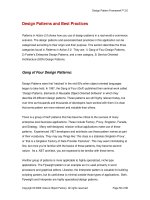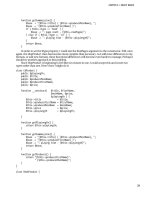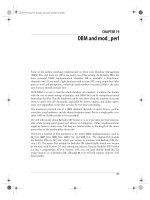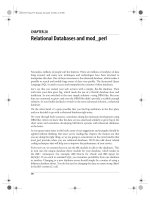Chapter 20 Patterns and UML pot
Bạn đang xem bản rút gọn của tài liệu. Xem và tải ngay bản đầy đủ của tài liệu tại đây (318.33 KB, 32 trang )
Chapter 20
Patterns
and UML
Copyright © 2006 Pearson Addison-
Wesley. All rights reserved.
20-2
Learning Objectives
♦
Patterns
♦
Adapter pattern
♦
Model-View-Controller pattern
♦
Sorting pattern and it’s efficiency
♦
Pattern formalism
♦
UML
♦
History of UML
♦
UML class diagrams
♦
Class interactions
Copyright © 2006 Pearson Addison-
Wesley. All rights reserved.
20-3
Introduction
♦
Patterns and UML
♦
Software design tools
♦
Programming-language independent
♦
Assuming object-oriented-capable
♦
Pattern
♦
Like "ordinary" pattern in other contexts
♦
An "outline" of software task
♦
Can result in different code in different but
similar tasks
♦
UML
♦
Graphical language for OOP design
Copyright © 2006 Pearson Addison-
Wesley. All rights reserved.
20-4
Patterns
♦
Patterns are design principles
♦
Apply across variety of software
applications
♦
Must also apply across variety of situations
♦
Must make assumptions about
application domain
♦
Example:
Iterator pattern applies to containers of
almost any kind
Copyright © 2006 Pearson Addison-
Wesley. All rights reserved.
20-5
Pattern Example: Iterators
♦
Recall iterators
♦
Iterator pattern applies to containers of
almost any kind
♦
1
st
described as "abstract"
♦
As ways of cycling thru any data in any container
♦
Then gave specific applications
♦
Such as list iterator, constant list iterator,
reverse list iterator, etc.
Copyright © 2006 Pearson Addison-
Wesley. All rights reserved.
20-6
Consider No Patterns
♦
Iterators
♦
Imagine huge amount of detail if all container
iterators presented separately!
♦
If each had different names for begin(), end()
♦
To make "sense" of it, learners might make
pattern themselves!
♦
Until pattern developed, all were different
♦
"Seemed" similar, but not organized
♦
Consider containers as well
♦
Same issues!
Copyright © 2006 Pearson Addison-
Wesley. All rights reserved.
20-7
Adapter Pattern
♦
Transforms one class into different class
♦
With no changes to underlying class
♦
Only "adding" to interface
♦
Recall stack and queue template classes
♦
Both can choose underlying class used to
store data:
stack<vector<int>> int stack under vector
stack<list<int>> int stack underlying list
♦
All cases underlying class not changed
♦
Only interface is added
Copyright © 2006 Pearson Addison-
Wesley. All rights reserved.
20-8
Adapter Pattern Interface
♦
How to add interface?
♦
Implementation detail
♦
Not part of pattern
♦
But… two ways:
♦
Example: for stack adapter:
♦
Underlying container class could be member
variable of stack class
♦
Or stack class could be derived class of
underlying container class
Copyright © 2006 Pearson Addison-
Wesley. All rights reserved.
20-9
Model-View-Controller Pattern
♦
Way of dividing I/O task out
♦
Model part: heart of application
♦
View part: output
♦
Displays picture of model’s state
♦
Controller part: input
♦
Relays commands from user to model
♦
A divide and conquer strategy
♦
One big task three smaller tasks
♦
Each with well-defined responsibilities
Copyright © 2006 Pearson Addison-
Wesley. All rights reserved.
20-10
Model-View-Controller Pattern
♦
Any application can fit
♦
But particularly suited to GUI
design projects
♦
Where view can actually be visualization of
state of model
Copyright © 2006 Pearson Addison-
Wesley. All rights reserved.
20-11
Display 20.1
Model-View-Controller Pattern
Copyright © 2006 Pearson Addison-
Wesley. All rights reserved.
20-12
A Sorting Pattern Example
♦
Similar pattern among "most-efficient"
sorting algorithms:
♦
Recursive
♦
Divide list into smaller lists
♦
Then recursively sort smaller lists
♦
Recombine two sorted lists obtaining one
final sorted list
Copyright © 2006 Pearson Addison-
Wesley. All rights reserved.
20-13
Sorting Pattern
♦
Clearly a divide-and-conquer strategy
♦
Heart of pattern:
int splitPt = split(a, begin, end);
sort(a, begin, splitPt);
sort(a, splitPt, end);
join(a, begin, splitPt, end);
♦
Note no details on how split and join
are defined
♦
Different definitions will yield different
sorting algorithms
Copyright © 2006 Pearson Addison-
Wesley. All rights reserved.
20-14
Function split
♦
Rearranges elements
♦
In interval [begin, end]
♦
Divides interval at split point, splitPt
♦
Two new intervals then sorted
♦
[begin, splitPt) – first half
♦
[splitPt, end) – second half
♦
No details in pattern
♦
Nothing about how rearrange and divide
takes place
Copyright © 2006 Pearson Addison-
Wesley. All rights reserved.
20-15
Function join
♦
Combines two sorted intervals
♦
Produces final sorted version
♦
Again, no details
♦
join function could perform many ways
Copyright © 2006 Pearson Addison-
Wesley. All rights reserved.
20-16
Sample Realization
of Sorting Pattern: Mergesort
♦
Simplest "realization" of sorting pattern is
mergesort
♦
Definition of split very simple
♦
Just divides array into two intervals
♦
No rearranging of elements
♦
Definition of join complex!
♦
Must sort subintervals
♦
Then merge, copying to temporary array
Copyright © 2006 Pearson Addison-
Wesley. All rights reserved.
20-17
Mergesort’s join Function
♦
Sequence:
♦
Compare smallest elements in
each interval
♦
Smaller of two next position in
temporary array
♦
Repeated until through both intervals
♦
Result is final sorted array
Copyright © 2006 Pearson Addison-
Wesley. All rights reserved.
20-18
Sort Pattern Complexity
♦
Trade-off between split and join
♦
Either can be simple at expense of other
♦
e.g., In mergesort, split function simple at
expense of complicated join function
♦
Could vary in other algorithms
♦
Comes down to "who does work?"
Copyright © 2006 Pearson Addison-
Wesley. All rights reserved.
20-19
Consider Quicksort
♦
Complexity switch
♦
join function simple, split function complex
♦
Library files
♦
Include files "mergesort.cpp",
"quicksort.cpp"
both give two different realizations of same
sort pattern
♦
Provide same input and output!
Copyright © 2006 Pearson Addison-
Wesley. All rights reserved.
20-20
Quicksort Realization
♦
A sophisticated split function
♦
Arbitrary value chosen, called "splitting value"
♦
Array elements rearranged "around" splitting value
♦
Those less than in front, greater than in back
♦
Splitting value essentially "divides" array
♦
Two "sides" then sorted recursively
♦
Finally combined with join
♦
Which does nothing!
Copyright © 2006 Pearson Addison-
Wesley. All rights reserved.
20-21
Sorting Pattern Efficiency
♦
Most efficient realizations "divide" list into
two chunks
♦
Such as half and half
♦
Inefficient if divided into "few" and "rest"
♦
Mergesort: O(N log N)
♦
Quicksort:
♦
Worst case: O(N
2
) (if split uneven)
♦
Average case: O(N log N)
♦
In practice, one of best sort algorithms
Copyright © 2006 Pearson Addison-
Wesley. All rights reserved.
20-22
Pragmatics and Patterns
♦
Patterns are guides, not requirements
♦
Not compelled to follow all fine details
♦
Can take "liberties" and adjust for particular needs
♦
Like efficiency issues
♦
Pattern formalism
♦
Standard techniques exist for using patterns
♦
Place of patterns in sofware design process
not yet clear
♦
Is clear that many basic patterns are useful
Copyright © 2006 Pearson Addison-
Wesley. All rights reserved.
20-23
UML
♦
Unified Modeling Language
♦
Attempt to produce "human-oriented"
ways of representing programs
♦
Like pseudocode: think of problem, without
details of language
♦
Pseudocode very standard, very used
♦
But it’s a linear, algebraic representation
♦
Prefer "graphical" representation
♦
Enter UML
Copyright © 2006 Pearson Addison-
Wesley. All rights reserved.
20-24
UML Design
♦
Designed to reflect/be used with
object-oriented programming philosophy
♦
A promising effort!
♦
Many companies have adopted UML
formalism in software design process
Copyright © 2006 Pearson Addison-
Wesley. All rights reserved.
20-25
History of UML
♦
Developed with OOP
♦
Different groups developed own graphical
representations for OOP design
♦
1996:
♦
Booch, Jacobsen, Rumbaugh released
early version of UML
♦
Intended to "bring together" various other
representations to produce standard for all
object-oriented design









